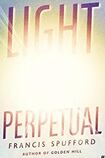
On a Saturday lunchtime in November 1944, a German rocket exploded at a London branch of Woolworths. Francis Spufford takes this historical event as the catalyst for unspooling the unlived lives of five fictional victims in his new novel. It is hard to see the necessity for the literary conceit. This is not a book about the butterfly effect: the variable potentials or endless possibilities of human fate. Anyway, could anyone do that better than Kate Atkinson in Life After Life or Jenny Erpenbeck in End of Days?
Basically: don’t believe the blurb. What Light Perpetual really is, is a magnificently observed love letter to London, and a powerful celebration of the wonders of ordinary life.
If the historic beginning of the book is not particularly important, it does provide Spufford with a starting point from which he can observe his protagonists. The year 1944 is far enough away to allow him to chart the span of a life, as well as track the forces of a society that is rapidly changing in the wake of the second World War. The explosive beginning also helps him establish his interest in a frame-by-frame unfolding of time.
As the customers at Woolworths browse the latest shiny kitchen appliance, Spufford hones in on the descending rocket, slowing time down as he describes it to the “smallest, finest subdivisions” of a moment, where the layers of life’s “onion-skin pages” are revealed. This deep-textured approach resonates throughout Light Perpetual as Spufford visits his characters at 15-year intervals to see how their lives are transformed by the march of history.
By choosing five characters from a similar geographical area of London (a fictional working-class suburb called Bexford), Spufford demonstrates the fickle nature of opportunity, the importance of luck, and also the constancy and reinvention of the self that happens throughout a lifetime.
We meet the characters first as children in Halstead Road Primary School, where we already see their determining characteristics.
Firstly, there are twins Jo and Val, whose paths diverge dramatically as they reach adulthood. Jo reveals herself already as “wary of the whole species of men” while Val is “charmed, curious, unable to look away”. Jo becomes a gigging singer and gets stuck in an uncommitted relationship that thwarts her own ambitions of success. Val becomes the coerced wife of a violent skinhead, and her inability to look away has horrible consequences for both her and a young Indian man whose tragic fate changes the course of her life dramatically.
Horrible bully Vern, with “fists like pink sausages, when the butcher bunches them to wrap them up in paper”, is Spufford’s next interest. He becomes an opportunistic opera-loving property developer whose financial fate ebbs and flows with the British economy. Vern is a self-made man destined to be master of his own undoing.
We see clever Alec already sticking up for the underdog; he cannot help but use his wits to humiliate the teacher who has humiliated his peers. He becomes a Marxist and a compositor in a newspaper industry that is rapidly making his livelihood obsolete. The forced reinvention, however, reveals ambitions he never knew he had.
Finally, we meet gentle Ben, small for his age, head in “the cauliflower kingdom in the sky”, whose mental health struggles show us life on the edge, physically and metaphorically.
Dazzling lucidity
There are so many passages of dazzling lucidity in Light Perpetual, and the discrete characters allow Spufford to display his poetic prowess in a variety of contexts, from Vern’s cathartic emotional life in music, to Jo ruminating on the beauty of the youths she teaches, to the endless refractions of Ben’s whirling mind.
However, it is London itself – a “jumbled collage of blocks and spires and roofs and stacks [that] never stop changing, never ceases cell by cell to be demolished and then to rise again under the red lights of the cranes, whose hard angles and crumbling surfaces seem to fend you off, to push you back” – that provide the most transcendent moments in this fine, if misdirected, novel.
If you know London’s secrets, Alec observes from the top of the moving staircase at a Tube station, it will “yield a coddled concentrate, a devourable sweetness, veins of rich fat”. Spufford delivers this to the reader in juicy morsels, providing a rich and textured study of a city and some of the many hidden lives that it has punished and nurtured with its formidable indifference.









